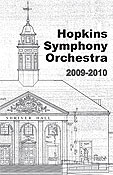Saturday, December 5, 2009
- 2009-2010 Season
- Symphony Orchestra
- Conductor: Jed Gaylin
- Works Performed:
- Prelude to Aïda by Giuseppe Verdi
- E lucevan le stelle (Tosca) by Giacomo Puccini
- Come dal ciel precipita (Macbeth) by Giuseppe Verdi
- Pace, pace mio Dio (La Forza del Destino) by Giuseppe Verdi
- Si, pel ciel marmoreo giuro (Otello) by Giuseppe Verdi
- Faust, Act V by Charles Gounod
- Messe solennelle de Sainte Cécile by Charles Gounod
- Featured Artists: Goucher Chorus Johns Hopkins Choral Society Lori Hultgren Richard Crawley Robert Cantrell
- Pre-Concert Speaker: Max Derrickson
- Venue: Shriver Hall
Concert Details




Program Details
Giuseppe Verdi: Prelude to Aïda
Giacomo Puccini: “E lucevan le stelle” from Tosca
Richard Crawley, tenor
Giuseppe Verdi: “Come dal ciel precipita” from Macbeth
Robert Cantrell, bass
Giuseppe Verdi: “Pace, pace, mio Dio” from La Forza del Destino
Lori Hultgren, soprano
Giuseppe Verdi: “Si, pel ciel” from Otello
Richard Crawley, tenor
Robert Cantrell, bass
Charles Gounod: Faust, Act V
Lori Hultgren, soprano
Richard Crawley, tenor
Robert Cantrell, bass
Johns Hopkins Choral Society & Goucher Chorus
Charles Gounod: Messe Solennelle (St. Cecilia)
Lori Hultgren, soprano
Richard Crawley, tenor
Robert Cantrell, bass
Johns Hopkins Choral Society & Goucher Chorus
Program Notes
Prelude to Aïda (1871)
Giuseppe Verdi
(born Le Roncole, Italy, 1813; died Milan, 1901)In 1869, after making some extraordinary archaeological finds, the famous Egyptologist Auguste Mariette claimed to have recreated an authentic story from the time of the Pharaohs about an Ethiopian woman named Aïda who is enslaved by her enemies, the Egyptians, while the two countries war. An Egyptian General, Radamès, falls hopelessly in love with Aïda. The story ends tragically, with Radamès entombed alive for his treasonous cavorting, and Aïda sneaking into the tomb so she can die with her beloved. Though reluctant at first, Verdi finally decided to write Mariette’s story into an opera. Contrary to most reckonings, it was not commissioned for the opening of the Suez Canal.
Aïda has become one of the most cherished of grand operas. The solemn and pensively beautiful Prelude was said to be Verdi’s answer to critics who claimed that he lacked mastery in counterpoint. Though this explanation may be apocryphal, the interwoven melodic lines are exquisitely haunting, ingeniously foreshadowing the complicated, heartrending relationships of the story’s main characters. It is not only the arresting melodies that Verdi uses, but, indeed, the stunning counterpoint, that make this Prelude a treasured concert favorite.
E lucevan le stelle (And the stars shone brightly) from Act III of Tosca (1900)
Giacomo Puccini
(born Lucca, Italy, 1856; died Brussels, 1924)With the fall of the pro-revolutionary Roman Republic in 1800, the despicable Baron Scarpia heads the secret police who brutally enforce order. Scarpia hates the painter and revolutionary Mario Cavaradossi, suspecting that Cavaradossi is harboring an escaped revolutionary, but also coveting Cavaradossi’s lover, the beautiful and temperamental diva Floria Tosca. Scarpia arrests our hero and, while torturing him, blackmails Tosca into agreeing to give herself to Scarpia in exchange for Cavaradossi’s life. Scarpia orders a “fake execution” of Cavaradossi, and then gives Tosca a document promising her and Cavaradossi safe passage out of Rome. When Scarpia embraces Tosca, she stabs him to death. She rushes to Cavaradossi’s prison cell at the Castel Sant’Angelo. She shows him the safe conduct and they believe that they will escape after the “fake execution.” But the firing squad uses real bullets. Baron Scarpia has had his revenge. Pursued by the executioners, Tosca leaps from a parapet to her death.
As Cavaradossi sits in his cell awaiting execution, he ruminates on his beloved Tosca and writes her a final letter. He remembers a beautiful night he spent with her when the stars shone brightly (“E lucevan le stelle”) and the earth was perfumed. The scene is quintessential Puccini, with a soaring, sobbing melody amidst brilliant orchestration, and tragedy lurking.
Come dal ciel precipita (How the darkness falls from heaven) from Act II of Macbeth (1847)
Giuseppe Verdi
Macbeth was Verdi’s first journey into Shakespeare’s genius, and Verdi’s enthusiasm lasted the rest of his life. His last two operas were Otello (1887) and Falstaff (1893). All three were resounding successes.
Macbeth tells of greed, murder, madness, and black magic in Ye Olde Scotland. As a war hero, MacBeth is greedy for more power, and his wife’s ambition is insatiable. After defeating armies from Ireland and Norway, Macbeth and his friend Banquo stumble across three witches. Their dark magic prophesies kingship for Macbeth and later for Banquo’s descendants. Macbeth and his wife quickly murder the current king and assume the throne. Then they kill Banquo and try to kill his son, to thwart the prophecy and guarantee Macbeth lineage. More murder follows. Ghosts and evil visions plague the new king and his wife, leading them to madness and, finally, Lady Macbeth to suicide. A distraught Macbeth returns to the three witches, whose new prophesies are ambiguous enough to play to Macbeth’s conceits. Soon his foes have rallied, marched upon Macbeth, and beheaded him.
Such melodrama, black magic, and intrigue allow for fantastic music-making by Verdi. In his Act II aria, Banquo realizes the danger to himself and his son.
Pace, pace mio Dio (Peace, peace, O God!) from Act IV Scene 2 of La Forza del Destino (The Force of Destiny) (1862)
Giuseppe Verdi
The story takes place in mid-18th Century Spain. When Leonora’s father tries to stop her and Alvaro from eloping, Alvaro drops his gun in supplication, but it fires and kills the father. The two lovers separate. Over the years Leonora becomes a religious hermit in a cave in the Spanish mountains. Eventually, the two believe each other to be dead. However, Leonora’s brother, Carlo, keeps pursuing Alvaro, vowing vengeance upon him and Leonora for their father’s death. At long last, Carlo and Alvaro meet. When they duel, Carlo is mortally wounded. He pleads for Last Rites. With the serendipity of opera, they just happen to be outside Leonora’s cave. Alvaro asks the “hermit” to administer to Carlo. All are stunned to see each other once again. When Leonora bends over Carlo, his hate gives him the final strength to stab her to death. The opera ends in a moving trio between the lovers and a priest as Leonora’s last breaths ebb away.
Just before the duel, Leonora broods in her cave. Though she has devoted her life to God, she cannot shake her memories of Alvaro. In one of the most moving and beautiful arias in opera, she beseeches God to end her joyless life. Verdi’s sweeping Destiny motive introduces the aria. Beneath Leonora’s exquisite melody, the harmonies are complex and agitated, continually shifting, betraying the torment coursing through her soul.
Si, pel ciel marmoreo giuro (Yes, by the marble heavens I swear) from Act II of Otello (1887)
Giuseppe Verdi
It is very difficult to adapt Shakespeare to the opera hall. Verdi’s Otello is widely considered to be the best operatic adaptation, not only because of Verdi’s long experience (including his very successful Macbeth 40 years earlier), but also because of the brilliant libretto created by the Italian poet and musician Arrigo Boïto. Boïto’s tight abridging of the play is itself considered a great literary feat, made possible in part by Boïto’s understanding of music. He knew what music could express when words ended, and he knew that of all opera composers, Verdi could best speak musically what was left unspoken.
Otello, a Moor and a general in the mighty Venetian fleet, sails home to Cyprus with his wife, Desdemona. Although she is unfalteringly faithful, her unsurpassed beauty keeps Otello in a state of near-constant jealousy. The evil Iago, one of Otello’s first mates, is bitter with Otello for promoting Cassio over him. Iago engineers Cassio’s demotion and then leads Otello to believe that Cassio is having an affair with Desdemona. The horrible result is Otello strangling his wife in her bed, and then learning of Iago’s treachery and killing himself. Otello and Iago sing Si, pel ciel at the end of Act II, when Iago pledges to help an enraged Otello discover whether Desdemona has been unfaithful.
Act V of Faust (1859)
Charles-François Gounod
(born Paris, 1818; died Saint-Cloud, France, 1893)Gounod’s Faust follows roughly the plot of Part I of the famous Goethe play, but with a few dramatic liberties. Goethe presents an aged Dr. Faust who, in his disillusionment with life and his science, appeals to the Devil, Mephistopheles, for youth and love. The “Faustian bargain” is made: Faust sells his soul, and the inevitable tragic consequences begin to mount. In Gounod’s opera, the love interest is the pure, innocent Marguerite. Faust seduces her and then leaves her pregnant, to pursue more youthful adventures. Shunned by society and shamed to her core, poor Marguerite murders her child and goes to prison. Act V opens just after Faust and Mephistopheles have partaken in a hellish bacchanal. But Faust, out of guilt and sincere love for Marguerite, persuades Mephistopheles to help him free his tormented lover from prison. The final scene takes place in Marguerite’s cell, where she, delirious and dying, repents to God and shuns Faust and Mephistopheles as they plead with her to escape. A choir of angels gathers to take their dear Marguerite with them to Heaven.
Messe solennelle de Sainte Cécile (1855)
Charles-François Gounod
- Kyrie
- Gloria
- Credo
- Offertory
- Sanctus
- Benedictus
- Agnus Dei
Hundreds of masses have been written before and since Gounod composed his Solemn Mass for St. Cecilia in 1855. Yet in terms of lyrical beauty, St. Cecilia should rank as one the great accomplishments in Western music. It seems nearly flawless in its sincerity and in its joyful awe for divine mysteries and promises.
During his lifetime, Gounod was one of the leading French composers, though known mainly for his operas. He was so renowned that the Khedive (King) of Egypt considered Gounod along with Wagner and Verdi for an invitation to compose Aïda, to inaugurate the Cairo Grand Opera House. Nevertheless, it was the St. Cecilia Mass that solidified Gounod’s reputation. In truth, his operatic expertise lent the Mass some of its dramatic effects.
Gounod’s devotion to Catholicism began around 1840, when he had won the coveted Prix de Rome for composition. Living in Rome, he found inspiration in the extraordinary religious paintings of Michelangelo and in the music of Palestrina and other 16th Century church composers. When Gounod returned to Paris, his deepening faith led him to seminary studies at Saint-Sulpice. He considered becoming a priest and, for a time, even referred to himself as Abbé Gounod. Gounod was also deeply moved by the Romantic authors like Goethe (especially his Faust), and by the sumptuous French poetry of Lamartine. These two muses, faith and romanticism, bring an enchanting juxtaposition to much of Gounod’s music. The Mass exemplifies the sensuous beauty of his works, and their simple, forthright expression.
The hagiography behind this Mass is an even grimmer tale than most saints’: Around the year 177, the Romans persecuted Cecilia for her Christianity, tried to boil her alive, and then tried to cut her head off. Miraculously, she survived for three days. Cecilia became the patron saint of music somewhat by mistake, when a Latin inscription of “organis” under a portrait of her was misinterpreted to mean that Cecilia herself played the organ. Thus, when the Academy of Music opened in Rome in 1584, Cecilia was made its patron saint, with a painting of her playing the organ. She has been associated with music ever since.
Although Gounod intended his Mass for St. Cecilia for both church and stage, his pious expression was no mere posturing. In fact, he wrote his own prayers to be spoken at the appropriate moments during the Mass Proper.
- As befits Cecilia’s somber martyrdom, he begins the Kyrie with a plaintive seven-note motif that grows out of the silence, gradually adding more instruments and a counter-line, and, finally, the choir. This reflective reverence soon transforms into a sweetly tender plea to Heaven, with a wafting arpeggiated accompaniment. The musical tension builds for a time over a sustained pedal note and then releases in a colossal, liberating cadence – one of Gounod’s dramatic signatures.
- The next two movements, the Gloria and Credo, are the cornerstones of the Mass and among the most stunning pieces of religious music ever written. An expression of ebullient adoration, the Gloria draws upon Gounod’s predecessors Bach and Handel. The musical variety is wonderful, especially in the lyric middle section’s rich solos for tenor, bass, and soprano. With a return to the first section, the Gloria ends with voices blazing.
- In the incomparable Credo, Gounod joyfully proclaims his faith. The motor-like accompaniment sounds like a child skipping in pure glee. In the middle section (Et incarnatus and Et resurrexit), the chorus parts are splintered into extra layers, with passages suggesting fantastical and mysterious wonderment.
- The Offertory is a lush orchestral interlude, a gentle contrast to all that precedes and follows it.
- In the poetic Sanctus, Gounod gives the solo tenor a sublime two-phrase melody followed by a half-bar of instrumental stillness. Gounod’s ability to adorn such a sensuous song so humbly brings a sense of deep contentment.
- The Benedictus is a simple hymn.
- The Agnus Dei finishes the Mass with a feathery lightness and a smiling lyricism.
Camille Saint-Saëns attended the premiere and aptly exclaimed, “The appearance of the Messe Saint-Cécile caused a kind of shock. This simplicity, this grandeur, this serene light which rose before the musical world like a breaking dawn, troubled people enormously… at first one was dazzled, then charmed, then conquered.”
Program Notes by Max Derrickson
